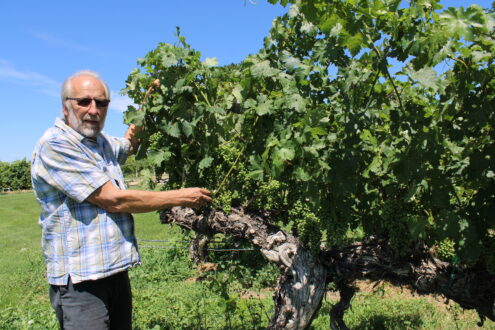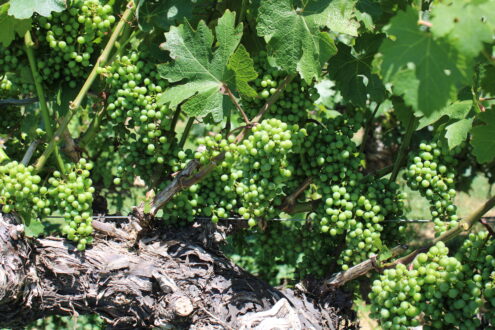

Mar 13, 2023Sagemoor Vineyards: Columbia River winegrape creation
Technology is an important part of Sagemoor Vineyards’ operations on hills above the Columbia River in Pasco, Washington.
In the face of a tighter labor supply, Sagemoor Vineyards relies on advances in farm machinery and performs other labor-saving operations in canopy management to more efficiently harvest winegrapes.
Growers benefit from machine harvesting, and other automated processes that cleans and prepares fruit for the fermentation process. Still lacking, however, is any mechanical operation that fully replaces the human touch in the vineyards, said Kent Waliser, director of vineyard operations.
“Grape growing for our customers is indeed a hands-on operation to get the quality needed for making great wine,” he said.
Labor tech help
Some tools have helped workers become more efficient in spraying, applying pesticides, managing canopies and removing leaves, shoots and suckers plus other more hand-driven applications. Mechanization has streamlined harvesting without sacrificing quality, Waliser said.
“Labor is our biggest ongoing concern and how we adapt growing methods to meet this labor shortage,” Waliser said. “If you don’t have sufficient labor, you can’t grow quality grapes, an integral part of the business. We have to continue to adapt to the availability of labor and absorb or pass on those costs to the consumers.”


Concern about manpower isn’t limited to vineyards. Harvests also stress wineries, which require people to process the grapes.
Growing grapes on 1,200 acres, Sagemoor is owned by Allan Bros. Inc., a Naches, Washington, fruit growing and packing operation with eastern Washington fruit orchards and vineyards. Five of Sagemoor’s six vineyards are in the Tri Cities area with another, acquired in 2021, in the neighboring Walla Walla area.
The bluffs of the picturesque Columbia River aid grape production, Waliser said. Because cold air can drift into low-lying areas, vineyards on side hills and bluffs benefit from increased air movement. The higher elevations keep plants warmer and less susceptible to frost, and also aid in ripening and disease management.
Great climate
“We have great weather here to grow grapes,” Waliser said. “We have adequate water to grow grapes, so they don’t require as much water as other crops.”
The Pacific Northwest’s generally drier conditions help reduce disease and pest pressure and foster quality. Powdery mildew is the single-biggest obstacle for Washington winegrape production, Waliser said. The fungal disease accompanies vinifera.
“If growers aren’t on top of their spray programs or if the weather throws us a curveball, we could have some crop losses due to powdery mildew,” Waliser said. “With insect pests, you have to look out for them and manage and tolerate them through spraying, but, in general, you won’t lose your crop to them. We have seen complete crop loss due to powdery mildew.”
Each Sagemoor vineyard block is irrigated separately, with viticulturists determining when and for how long based on needs of the variety, specifically red or white.
“There was a time when we didn’t distinguish that much between the two, but we are doing more of that all the time,” he said. “It has an impact on quality at the end of the year.”
Grape phylloxera, tiny aphid-like insects that can destroy plants, are a concern but not a crisis for some growers, Waliser said. Industry-developed resistant rootstocks have helped stem the problem. With the discovery of phylloxera, progressive growers are planting resistant rootstocks, he said.
As disease and pest pressures change, growing practices change, and Sagemoor has fine-tuned chemicals used and their rotations, along with updated irrigation processes and vineyard care protocols.
“You must continue to adapt to technology,” Waliser said. “Just having people observant in the vineyards and using the tools available, we have gained better cultivation and canopy management tools that work very well.”
In Washington, most wineries don’t grow their own grapes, but the situation is changing.
“It is a gradual process that wineries are buying or starting vineyards,” Waliser said. “It is a small percentage where this is happening on both sides. Growers making wine is happening, but also slowly.”
Only a handful of growers a year are making the change, but this wasn’t happening 20 years ago, he said. “It takes profit on both fronts to vertically integrate,” Waliser said.
Sagemoor works with its customers by keeping in contact via email and telephone is also important. As the season progresses, many winemakers make trips to the vineyard to check on Sagemoor’s work and the grapes, which becomes more frequent during harvest.
“Many winemakers trust us and their winery may be too far away to make trips, so we use email or phone or text to communicate,” Waliser said. In some cases after harvest, Waliser visits wineries to see how the wine turned out.
Nurturing flavor
A favorite saying at Sagemoor is that flavors are nurtured in the vineyard. The different wine flavor profiles originate in the vineyard, with wineries shepherding those flavors.
“A winery is not a hospital,” Waliser said. “Wine doesn’t get better there. You don’t take the grapes to the hospital to make them better. You take them to wineries to preserve what’s there.”
Otherwise, wineries would receive grapes from everywhere and produce similar tasting wines.
Sagemoor’s land was purchased by four partners in 1968 and the first vines were planted in 1972. The original owners, Alec Bayless, Albert Ravenholt, Winslow Wright and Syd Abrams, are credited with pioneering Washington’s early wine industry with their vision.
In 2002, Waliser joined Sagemoor. The 30-year apple industry veteran, who grew up on his family’s apple farms in nearby Milton-Freewater, Oregon, worked in operations, sales and marketing for companies including Dole in Wenatchee, Washington. In 2014, Allan Bros. purchased Sagemoor from its founders and other investors. Allan Bros. carried on with the same employees and business plan.
Waliser puts a premium on people. He points to Lacey Lybeck, Sagemoor’s vineyard operations manager, as a young viticulturist who’s attuned to technology and adapting different growing methods to control costs and harvest quality grapes.
“At the end of the day, it’s all about people,” Waliser said. “You can be in the right spot at the right time with the right varieties, but if you haven’t invested in the right people and the right team, you won’t rise above average.”
— Doug Ohlemeier, assistant editor
Top photo: Sagemoor Vineyards’ Kent Waliser views winegrapes. Sagemoor uses farm machinery to save labor in canopy management to more efficiently harvest winegrapes. Photos: Doug Ohlemeier
Second photo: Sagemoor Vineyards grows Cabernet Sauvignon winegrapes planted in 1972 and more than a dozen other grape varietals.
Bottom photo: Sagemoor Vineyards grows winegrapes on hills above the Columbia River north of Pasco, Washington. The bluffs aid grape production through “wind air drainage,” which helps keep the grapes warmer and less susceptible to frost.















